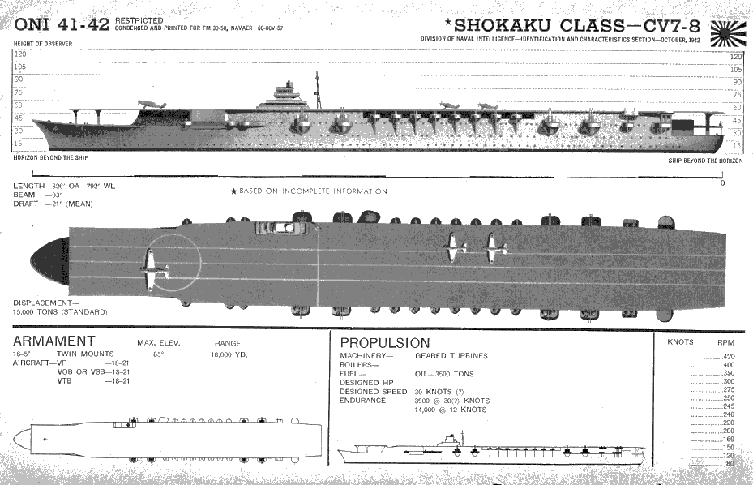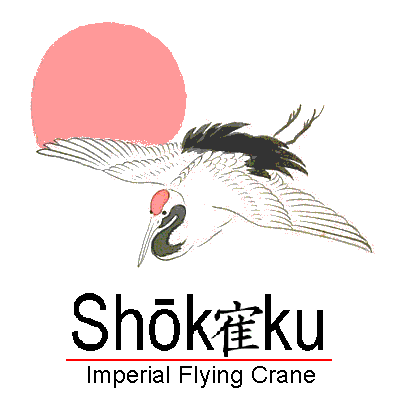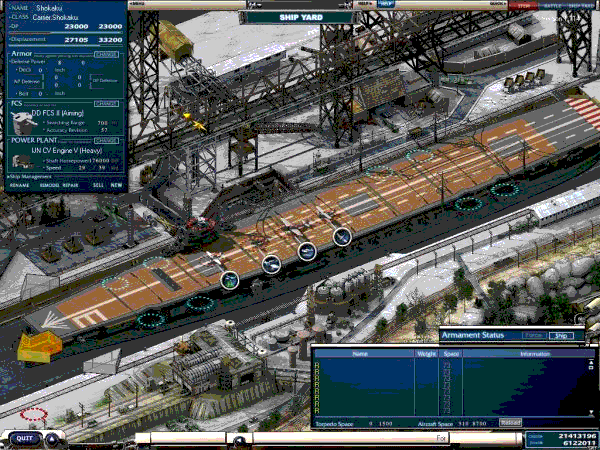
Imperial Japanese Navy - SHOKAKU Aircraft Carrier ==========================================================================

The Shokaku (ôFlying Craneö) and Zuikaku (ôLucky Craneö) were Japan's next venture into aircraft carrier construction following the Soryu and Hiryu. These carriers were kept fairly well under wraps, insofar as specifications are concerned. They were authorized under the very ambitious Fleet Replenishment Program of 1937, the same program under which the famed super battleships Yamato and Musashi were built. Shokaku was laid down December 12, 1937 at the Yokosuka Navy Yard, while Zuikaku was started at Kawasaki Dockyard May 25, 1938.
These two carriers were brand spanking new at Pearl Harbor, and participated in almost every major carrier battle during the war. They were among the best of the Japanese carriers; big, fast, durable, and handsome.
The Sh˘kaku class were part of the same program that also included the Yamato-class battleships. With an efficient modern design, a displacement of about 30,000 tons, and a top speed of 34 knots (63 km/h), Sh˘kaku could carry 70 to 80 aircraft. Her enhanced protection compared to contemporary Allied aircraft carriers enabled Sh˘kaku to survive serious battle damage during Coral Sea and Santa Cruz, although she met her end from submarine torpedoes.
Sh˘kaku and her sister ship Zuikaku, formed the Japanese 5th Carrier Division, acquired their aircraft shortly before the Pearl Harbor attack and were ready just in time for it. Her aircraft complement consisted of 15 Mitsubishi A6M fighters, 27 Aichi D3A dive bombers, and 27 Nakajima B5N torpedo bombers
Basically, the ships had similar specifications. They displaced 25,675 tons standard, had a designed speed of 34.2 knots, carried 16 five-inch guns in twin mounts, and could carry up to 84 aircraft, although a normal complement was 73. There were no major differences between the ships. Zuikaku, however, was fitted with a bulbous bow, the first Japanese warship so designed. Shokuku was launched June 1, 1939, and completed August 8, 1941; Zuikuku was launched November 27, 1939, and completed September 25, 1941.
Completion of both carriers was delayed when the original funnel arrangement was changed in mid-construction by the Aeronautical Headquarters. As designed, the funnels were to appear one on each side of the island bridge, fore and aft on the starboard side. This was changed by placing the two funnels immediately aft of the island. Critically, concrete was used to fill the air spaces around the aircraft fuel tanks to avoid replication of the destructive fires that occured on the carriers at the Battle of Midway.
The Japanese did not give either ship much publicity. Both ships, Zuikaku and Shokaku, were to figure prominently in most sea battles of WW II involving naval air. Their design was based on the best material gathered from experiences in Akagi, Kaga, and the Soryu types. Later Japanese carriers (i.e., multiple ship design classes) were constructed in two groups: the large to be like Taiho (with armored flight deck), and the medium to be repeats of the Soryu class. Zuikaku and Shokaku comprised an entire class.
With Zuikaku, Sh˘kaku joined the Kido Butai (Pearl Harbor attack force) and participated in Japan's series of early wartime naval offensives, including an attack on Rabaul in January 1942, and the Battle of the Coral Sea in May.
In the Indian Ocean raid of March 1942, she joined the aircraft carriers Akagi, Zuikaku, S˘ryű, and Hiryű in raiding Colombo. There Admiral Chuichi Nagumo succeeded in extensively damaging support facilities.
That task completed, the task force found and sank the British carrier Hermes, and two cruisers (Cornwall and Dorsetshire), prior to moving on to the Coral Sea. Here she helped to sink USS Lexington, but was herself severely damaged by USS Yorktown's aircraft in return.
After repairs, Sh˘kaku took part in two further 1942 battles, both in concert with her sister: the battle of the Eastern Solomons, where they damaged USS Enterprise, and the battle of the Santa Cruz Islands, where they sank USS Hornet but Sh˘kaku was once again seriously damaged by dive bombers from USS Yorktown (CV-5) and had to return to Japan for repairs.
In 1943 under the command of Captain Matsubara Hiroshi, she resumed her role as one of the Japanese Navy's most important fleet carriers. She was assigned to a counter-attack against the Aleutian Islands, but the operation was cancelled after the Allied victory at Attu. For the remainder of 1943 she was based at Truk.
From 1943-44, she continued operations as one of the Japanese Navy's most important fleet carriers. Shokaku was sunk by the U.S. submarine Cavalla (SS-244) on 19 June 1944, during the Battle of the Philippine Sea.
The Shokaku was indeed a famous ship, and battle-scarred as well. Her illustrious record included such battles as the attack on Pearl Harbor, the Indian Ocean sorties, the Battle of Coral Sea, and the naval battles around Guadalcanal. With sister-ship Zuikaku as part of CarDiv 5, the Shokaku had participated in nearly every carrier battle except Midway. Indeed, some historians cite the absence of the Shokaku and Zuikaku -- recovering from Coral Sea damage or losses -- as the deciding factor in the Japanese defeat at Midway. Whether that is true or not, there was no denying that Shokaku's record and crew were both of the highest standing. It was natural, then, that she and her sister should be teamed with the grand new carrier Taiho when Admiral Ozawa set forth to challenge the U.S. invasion of Saipan in June 1944.
It was widely hoped that the unprecedented combination of Imperial sea and land-based air forces would turn the tide at the Battle of the Philippine Sea, but it was not to be. Taiho would perish from complications arising from a single torpedo hit, and Shokaku herself would be sunk this selfsame day by the same agent -- U.S. submarines. Yet that sinking is veiled by a remarkable reticence of detail -- a frustrating brevity of story that forms an unsatisfactory end to such a brilliant career. The reason is that the bulk of the Shokaku's Detailed Action Report for this battle has apparently been lost or destroyed.
In the Battle of the Philippine Sea (called the Battle for the Marianas by the Japanese), the Imperial Japanese Navy lost three aircraft carriers within a period of thirty-six hours. These were the Taiho, Shokaku, and Hiyo. All three were victims of the same fateful combination of torpedo damage that set up massive vapor-induced explosions. Adequate reports exist for the Taiho and, to a lesser degree, for the Hiyo's loss. The veteran and famous Shokaku was torpedoed and sunk by U.S.S. Cavalla (SS-244) on 19 June 1944.
After losing the carrier Hiyo and suffering more damage in the TF 58 air attack of 20 June, the defeated Mobile Fleet returned to the homeland, anchoring at Nakagasuku Bay, Okinawa on the afternoon of the 22nd. There, survivors of Taiho and Hiyo were transferred to Shokaku's sister carrier Zuikaku. Probably for reasons of space, but perhaps to spare them the disorientation of being aboard a "ghost" of their lost vessel, the Shokaku's survivors were transferred instead to heavy cruiser Maya; upon which they returned home on 24 June. After the loss of his ship, Captain Matsubara Hiroshi returned to Japan and on 30 June was assigned to the Yokosuka Naval District. Shortly after he was transferred to Sasebo as commander of the Naval Barracks, and subsequently finished out the year as an Instructor at the torpedo school.
Shokaku's sister ship, Zuikaku, took part in the attack on Pearl Harbor. During the great Japanese Pacific offensive of late 1941 and early 1942, Zuikaku was a participant in attacks on Rabaul, the East Indies, and the Indian Ocean. While covering an intended invasion of Port Moresby, New Guinea, in early May 1942, Zuikaku and Shokaku formed the Japanese side of the World's first significant battle between aircraft carriers, the Battle of the Coral Sea. On 8 May, her planes helped disable USS Lexington (CV-2) and damage USS Yorktown (CV-5). In return, Shokaku was seriously damaged, and Zuikaku's air group was greatly depleted, ensuring that both ships were unavailable for the pivotal Battle of Midway in June.
During the rest of 1942, Zuikaku was an important component of the Japanese forces involved in the Guadalcanal campaign, taking part in the carrier battles of the Eastern Solomons in August and Santa Cruz Islands in October. After the long lull in carrier actions that covered all of 1943 and the first part of 1944, Zuikaku again engaged her American opposite numbers in the Battle of the Philippine Sea, on 19-20 June 1944. That action, which cost Japan three more carriers, hundreds of planes and most of the rest of her trained carrier pilots, reduced her once-irresistable aircraft carrier fleet to a state of virtual impotence. Zuikaku was damaged in the battle, but was soon repaired.
In October 1944, Zuikaku led the remaining Japanese carriers in the role of "bait" to divert U.S. carrier planes away from the surface forces that were attempting to attack U.S. ships off Leyte, in the Philippines. This mission was successful, though it did not lead to Japanese victory in any component of the Battle of Leyte Gulf, and it came at great cost to Zuikaku and her consorts, who had few planes embarked to defend themselves. In the resulting Battle off Cape Engano, on 25 October 1944, the four Japanese aircraft carriers were repeatedly hit by U.S. carrier planes' bombs and torpedoes. All of them, including Zuikaku, were sunk.
=================================================================================
NB: The above text has been collected / excerpted / edited / mangled / tangled / re-compiled / etc ... from the following online sources :
IJN - SHOKAKU class Aircraft Carriers - wikipedia article #1
IJN - SHOKAKU class Aircraft Carriers - wikipedia article #2
IJN - SHOKAKU class Aircraft Carriers - www.globalsecurity.org
IJN - SHOKAKU class Aircraft Carriers - www.combinedfleet.com article#1
IJN - SHOKAKU class Aircraft Carriers - www.combinedfleet.com article#2





